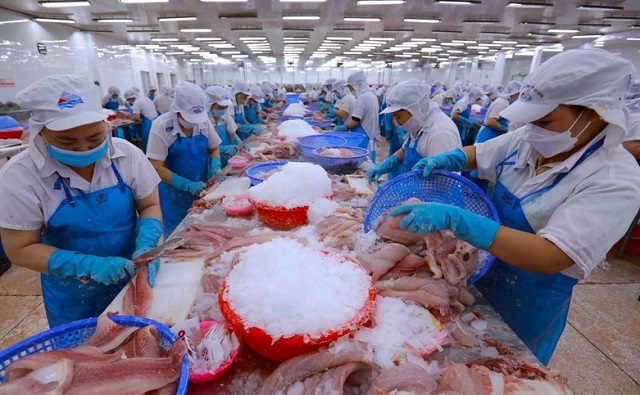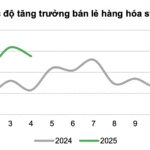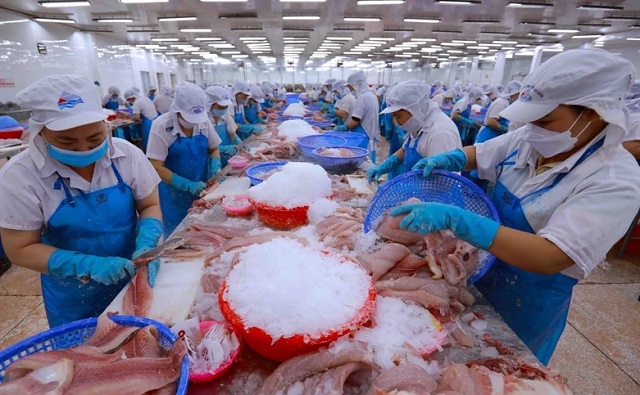
|
Seafood processing for export. (Photo: Vu Sinh/VNA)
|
The Vietnamese economy is experiencing a strong recovery, despite a still uncertain global context.
Positive assessments from international organizations such as the International Monetary Fund (IMF), the Organization for Economic Cooperation and Development (OECD), and the World Economic Forum (WEF), along with in-depth analysis from UOB Bank (Singapore), all point to growing confidence in Vietnam’s long-term economic potential.
However, to maintain sustainable growth, Vietnam needs to continue adapting and accelerating reforms in the context of a volatile external environment.
Positive Growth and International Attention
Vietnam has started 2025 on a positive note, with a GDP growth rate of 6.93% in the first quarter, following an impressive recovery in 2024 with a growth rate of 7.09%.
These figures reflect the country’s agility in economic management and its ability to adapt to external challenges.
At a meeting with Prime Minister Pham Minh Chinh on the sidelines of the WEF Tianjin 2025, WEF’s Interim Chairman Peter Brabeck-Letmathe affirmed that Vietnam is playing an increasingly prominent role in the global economic network.
According to Mr. Brabeck-Letmathe, flexible governance and autonomous foreign policies have created a strong appeal for the international business community.
Additionally, the Memorandum of Understanding (MOU) between Vietnam and the WEF, signed in Tianjin in 2023, has connected Vietnam with many global corporations, expanding opportunities for high-quality foreign investment.
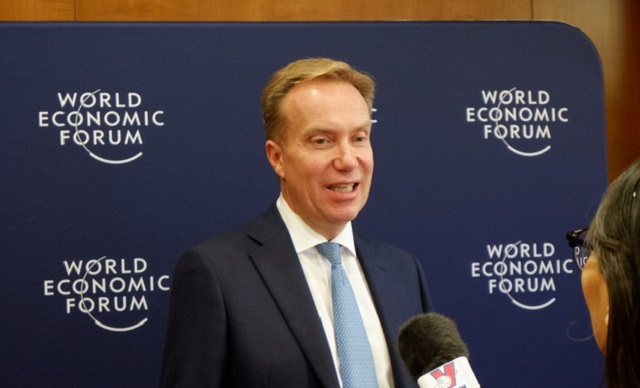
|
WEF President Borge Brende talks to VNA reporters at the WEF headquarters. (Photo: VNA)
|
Sharing this positive view, WEF Executive Chairman Borge Brende highly appreciated Vietnam’s two-digit growth target for the next decade, considering it a feasible strategy if Vietnam maintains its current momentum.
Meanwhile, the Organization for Economic Cooperation and Development (OECD), in its Vietnam Economic Report 2025 released in mid-June 2025, stated that Vietnam has made important long-term strides.
OECD Chief Economist Alvaro Pereira expressed his belief that Vietnam is fully capable of becoming a high-income country by 2045 – or even earlier if it continues its reform and integration efforts.
From the perspective of the private sector, UOB Bank also noted a clear recovery of the Vietnamese economy in the second quarter of 2025.
According to the latest forecast, GDP in the second quarter of 2025 is estimated at 6.1%, thanks to the US tax deferral policy and proactive actions by the Vietnamese government and businesses.
UOB’s survey also showed that 60% of Vietnamese businesses remain optimistic about their growth prospects in the coming year, and nearly half plan to expand into international markets.
External Risks Remain
Despite positive growth signals, the Vietnamese economy still faces challenges, especially from the external environment.
The International Monetary Fund (IMF) warns that Vietnam’s growth prospects depend largely on the outcome of trade negotiations, while global uncertainty remains high.
Mr. Paulo Medas, Head of the IMF’s Vietnam Surveillance and Macroeconomic Analysis Division, noted that externally, escalating trade tensions will create challenges for export-oriented businesses.
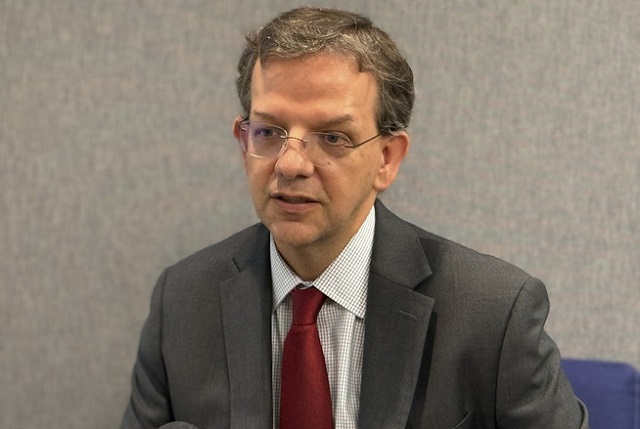
|
Mr. Paulo Medas, Head of the IMF’s Vietnam Surveillance and Macroeconomic Analysis Division. (Photo: Doan Hung/VNA)
|
Domestically, financial pressures could also increase due to tighter credit conditions and high corporate debt levels.
Notably, both UOB and the IMF mentioned the impact of US tariff policies.
The US announcement in early April 2025 to impose a 46% tariff on some Vietnamese exports created concerns in the global market. However, the US later postponed the implementation for 90 days to allow for negotiations.
According to UOB, Vietnam’s exports rely heavily on key industries such as electronics, furniture, textiles, and footwear, which account for about 80% of exports to the US. Therefore, any changes in trade policies can have a significant impact.
Adaptability and Reform as the Foundation
In the face of risks, international organizations have recognized Vietnam’s efforts to maintain macroeconomic stability and promote reforms. The IMF suggested that fiscal policy should play a leading role in economic management, especially when Vietnam’s public debt remains low. Additionally, accelerating public investment and expanding the social safety net will help lay the foundation for supporting growth in the short term.
In terms of monetary policy, the IMF recommended focusing on stabilizing inflation expectations and allowing for more flexible exchange rates to adapt to external shocks. At the same time, modernizing the monetary policy framework – such as replacing the credit growth cap with a prudential policy framework – will contribute to more effective management.
The OECD emphasized the importance of institutional reforms, including broadening the tax base, improving the social welfare system, and promoting renewable energy. In particular, attracting high-quality FDI should go hand in hand with enhancing domestic capacity, protecting intellectual property rights, and developing human resources.
According to the UOB survey, about 80% of exporting businesses have proactively responded to tariff risks with various solutions: from diversifying supply chains and increasing localization to investing in digitalization and sustainable development.
Notably, many businesses are looking at the ASEAN and European markets as potential destinations to reduce dependence on traditional markets.
Despite short-term difficulties, the medium and long-term prospects for the Vietnamese economy remain positive in the eyes of international organizations. The IMF and OECD both believe that with a solid macroeconomic foundation, clear reform orientation, and proactive actions by businesses, Vietnam can maintain stable growth and enhance its position in the global value chain.
UOB forecasts Vietnam’s GDP growth to reach 6% in 2025 and increase to 6.3% in 2026. In the context of a restructuring global economy, if Vietnam maintains its reform determination, improves productivity, and enhances competitiveness, it can seize new opportunities to break through./.
Dio Linh
– 14:38 30/06/2025
4,000 Retail Outlets: WinMart+ Dominates the Domestic Market
On June 28th, WinMart+ reached a significant milestone with its 4,000th store opening across Vietnam, celebrating a decade of serving millions of Vietnamese families. Strategically located at 202 Nam Ky Khoi Nghia Street, My Tho City, Tien Giang Province, the 4,000th WinMart+ store offers a modern shopping experience, featuring a wide range of quality products and a diverse assortment of goods to cater to the needs of its customers.
The Retail Empire of Billionaire Nguyen Dang Quang Reaches 4,000 Stores in a Decade
WinMart+ celebrates the opening of its 4,000th store in My Tho City, Tien Giang Province, marking a decade of growth and success for the renowned retail chain.
Masan Group Aims for 1.5 Trillion VND in Profit in Q2, a Surge of Over 50% Year-on-Year.
According to consensus estimates from securities firms, this growth was driven by the strong performance of two core businesses: WinCommerce’s (WCM) retail segment and Masan Consumer Holdings’ (MCH) consumer goods division.

